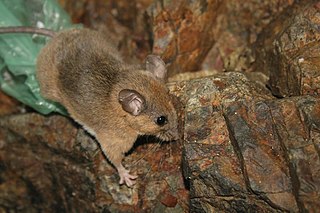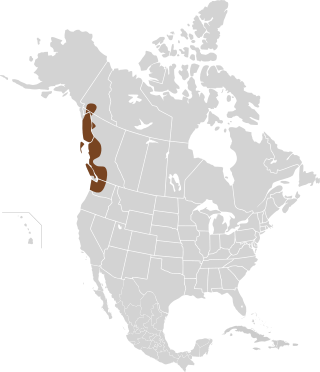
The Perote mouse, or Perote deer mouse, is a species of rodent in the family Cricetidae. It is found only in Mexico.
Burt's deer mouse is a species of rodent in the family Cricetidae. It is endemic to Mexico, where it is found only on Montserrat Island off the east coast of Baja California Sur. The species is threatened by predation by feral cats.
Dickey's deer mouse is a species of rodent in the family Cricetidae. It is endemic to Mexico, being found only on a small island in the Gulf of California. The species is named for Donald Dickey, who sponsored the expedition that first discovered the animal.
The big deer mouse is a species of rodent in the family Cricetidae. It is found only in Guatemala.
Osgood's mouse is a species of rodent in the family Cricetidae. It is found only in Mexico. Its name references Wilfred Hudson Osgood.
The Guatemalan deer mouse is a species of rodent in the family Cricetidae. It is found in Guatemala and Mexico.
The naked-eared deer mouse is a species of rodent in the family Cricetidae. It is found in El Salvador, Guatemala, Honduras, Mexico, and Nicaragua.
The San Lorenzo mouse is a species of rodent in the family Cricetidae. It is endemic to Mexico, where it is found only from the islands of San Lorenzo Norte, San Lorenzo Sur, and Salsipuedes off the east coast of Baja California. The species is threatened by predation by feral and domestic cats, particularly on San Lorenzo Sur.

The Tres Marías island mouse or Tres Marías deer mouse is a species of rodent in the family Cricetidae. It is found only on the Islas Marías off the west coast of Mexico. When last assessed, it was common on María Cleofás Island, but rare or absent on the other, more disturbed, islands.
The brown deer mouse is a species of rodent in the family Cricetidae found only in Mexico.
The plateau mouse is a species of rodent in the family Cricetidae. It is found only in Mexico.

The northwestern deer mouse or Keen's mouse is a species of rodent in the family Cricetidae. It is found in British Columbia in Canada and in Alaska and Washington in the United States. It was named after the Rev. John Henry Keen in 1894.
The false canyon mouse or Coronados deer mouse, is a species of rodent in the family Cricetidae. It is known only from Coronados Island, a small island in the Gulf of California, part of Baja California Sur, Mexico. The species is threatened by predation by feral cats, and the IUCN has assessed its conservation status as "critically endangered".

Slevin's mouse, also known as the Catalina deer mouse, is a species of rodent in the family Cricetidae. It is endemic to Isla Santa Catalina off the east coast of Baja California Sur, an island with an area of about 40 km2 (15 sq mi), and it is the only native mammal on the island. It is named for Joseph Slevin, a curator at the California Academy of Sciences.
The gleaning mouse is a species of rodent in the family Cricetidae. It is found only in Mexico.
The San Esteban Island mouse is a species of rodent in the family Cricetidae. It is endemic to Mexico, where it is known only from San Esteban Island in the northern Gulf of California.
The Yucatan deer mouse is a species of rodent in the family Cricetidae. The species is found in Mexico and Guatemala; an example habitat is the Petenes mangroves ecoregion of the Yucatan.
Geoxus annectens, also known as Pearson's long-clawed akodont or Pearson's long-clawed mouse, is a species of rodent in the tribe Abrotrichini of family Cricetidae. Molecular data suggests that its closest relative is Geoxus valdivianus. Formerly classified in its own genus, Pearsonomys, named after American zoologist Oliver Payne Pearson, it was moved to Geoxus in 2016 after a morphological and genetic reevaluation of the tribe Abrotrichini. This rodent is endemic to Chile, where it is found in Nothofagus forest of the Valdivian temperate rainforest ecoregion.
Habromys schmidlyi, sometimes known as Schmidly's deer mouse, is a species of rodent in the family Cricetidae found only in Mexico. Its natural habitat is cloud forest in the Sierra de Taxco, on the border of Guerrero and Mexico states, above 1,800 meters elevation.




